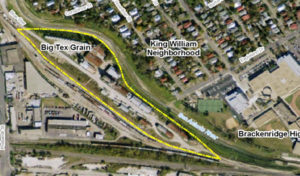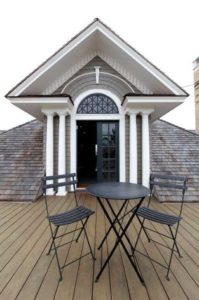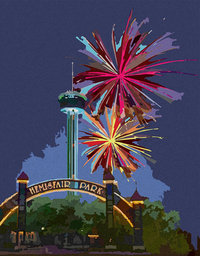Big Tex revival getting new life
Visions of what a redeveloped site could become are aired at meeting.
By: Valentino Lucio for San Antonio Express-News
For years, there have been plans to renovate the abandoned Big Tex plant situated along the San Antonio River, near the Blue Star Arts Complex. While environmental issues and a down economy stalled the project, stakeholders are ready to breathe new life into it.
A dialogue started Monday when about 40 people gathered at Blue Star to share their vision for the 7.5-acre development.
Although the plan still is in its infancy and has no funding, the mixed-use development aims to incorporate a boutique hotel, 230 rental lofts, live-work space for artists, retail space, a conference center and a parking garage.
Plus, it would allow the 25-year-old Blue Star Contemporary Arts Center, the main gallery space at Blue Star, to expand from the 12,000-square-foot space it currently occupies and has outgrown. Plans call for it to occupy another 15,000 square feet at the new site, allowing for more space for art exhibits and educational classes.
“We’re practically hanging from the rafters in the facility we have now,” said Bill FitzGibbons, president and executive director for the arts center.
Irby Hightower, principal with Alamo Architects, the designer for the project, said that the existing silos and structures are stable and still can be utilized. The project’s design will resemble the original site, expanding on the industrial and warehouse feel. What could be different is that it could incorporate more outdoor space, which the original 135,000-square-foot arts complex lacks, he said.
The property’s owner,James Lifshutz, said the project still is in the site-planning stage and that there isn’t a timeline for development.
He anticipates the project could cost about $40 million, with funding coming from the public and private sectors. The hope, he added, is that the expansion project, like the original arts complex, could be the economic generator that continues to revitalize the area.
“The same way Blue Star anchored the commercial redevelopment south of Durango Street starting 25 years ago, I think we have the potential to have the same kind of leveraging affect with the Blue Star’s expansion,” he said.
At the meeting, stakeholders chimed in with ideas about what they would like to see at the site. Several suggestions were mentioned, including a farmers market, pharmacy, community garden, grocery store and restaurants.
And with the city’s efforts to redevelop the San Antonio River to the south, some stakeholders said that the expansion project could become the entry point to the San Antonio Missions.
While the future may be bright for the area, the project has had its troubles. In 2009, the Environment Protection Agency finished cleaning up about 2,000 tons of asbestos-contaminated soil from the site, which had been operated as a processing plant for vermiculite ore.
The cleanup cost about $2.75 million and the EPA is seeking reimbursement for the costs. While the project site has been deemed safe, Lifshutz said he hasn’t paid into the cleanup costs and was not aware of any previous owners contributing to the bill.
And with so much negativity connected to Big Tex, the processing plant’s original name, Lifshutz said he will drop that moniker and use Blue Star to refer the entire complex.Although the project still is a dream, Lifshutz said that community involvement in the process is essential to the project’s success.
“I don’t want to give the impression that it’s a done deal, ready to break ground,” Lifshutz said. “On the other hand … we’re trying to make sure that what we eventually design and build is something that will be not only well received by the community nearby but the entire South Side.”














